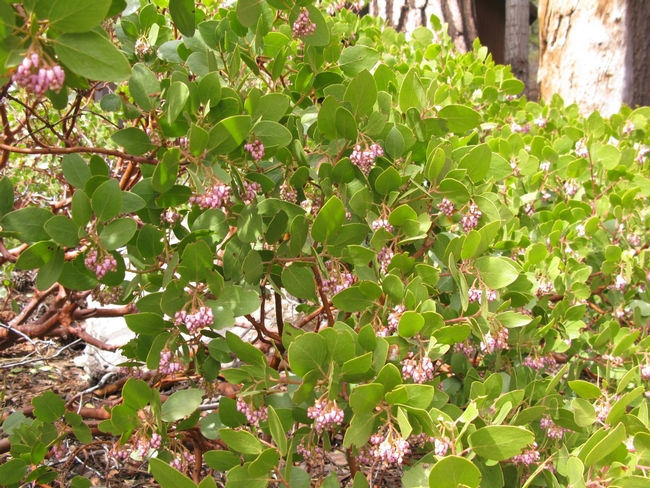- Author: Carmen Vannoy

It's important to remember that collecting plants on public lands always requires approval and a permit. To purchase plants, check with your local nursery, many nurseries are carrying more native plants for sale. Also visit the local California Native Plant Society plant sales. Manzanita is a slow growing plant, often available from specialty native plant nurseries.
If you have a friend or neighbor with manzanita, some species can be propagated by a technique called layering. Layering is done by “pinning” down a tender branch into the soil with a U-shaped piece of wire. It is left to root for a growing season. At the point where the branch touches the soil, wound the bark with a sharp, clean knife and give it some supplemental water. After roots have grown at the wound site, the rooted branch can be severed from the older plant, given time to recover and transplanted in the fall or next season.
Greenleaf manzanita is shown to occur in our area into West Bishop, and ranging into higher elevations. In my high elevation yard I have a couple of manzanita plants, which I believe to be greenleaf manzanita. The larger bush predates my house of 30 years by I don't how long. It is about ten feet across and four feet high. It has been there thriving without any help from me for its entire life, nor does it seem to need any help. I have thinned the branches to reduce fire fuel loads but not too much as the bark can sun scald and crack without its protective leaf canopy. These thinned out branches are never thrown away by me, instead I know several people who love to use them as decorations, the smooth red bark and twisting branches look good for years and I still see them in homes they went to 25 years ago.
Besides beautiful deep red bark, manzanitas have evergreen leaves, which in my yard pop out of the snow each year as winter slow, looking unconcerned by the heavy load they may have received. In spring lovely white to pink flowers bloom, shaped like upside down urns. The flowers are small but form clusters of pink and white against the dense foliage.
The shrub is a nursery and shelter to wildlife. I've seen generations of blackbirds and robins fledge from nests within its' branches. Last year I watched as four young Steller's Jays waited in the center of the manzanita for mom or dad to bring tasty treats. The flowers attract butterflies and other flying insects. A variety of bee, I suspect, is the one making little holes at the base of many flowers to get at the nectar but I also photographed a butterfly using the same access to the flower.
This spring on warm days I've had clouds of butterflies and moths feeding at the manzanitas. So far this year most have been Painted Lady Butterflies and a few Red Admirals visiting the flowers. The moths, or maybe they are skippers, are too fast for me to see who they are but if I stand still the butterflies feed close by. Occasionally they land on me but in inconvenient spots for a close up photograph, the back of my shoulder seems a good spot to a butterfly, or maybe a rest on the toe of my shoe.
I have never seen an insect pest problem on my manzanitas, although they do host some caterpillars. I have had aphid problems on several plants, but have not had a problem on mymManzanitas. If they do get insect pests, the damage appears to be minimal. And for the larger garden munchers who frequent my yard, I have seen ground squirrels take the tips of the bush to not much detriment, but have never seen deer munch on it, and they generally try everything in my yard.
At the end of the summer, the flowers have produced little fruits that look like miniature apples. It's this aspect that inspired the Common name of manzanita, in Spanish it means little apple. The fruits are favorites of many birds and mammals, even the bears feed on them. And in looking up the species name of Arctostaphylos I have found it is from the Greek words of arctos for Bear and staphyle for grapes. If I needed further proof of the inspiration for this name, I only need reminding from my neighbor who had often seen a mama bear and two cubs last year, foraging on the small fruits on my manzanita plants. With all the use the plants get from my wild neighbors, it always looks good without any effort on my part, which is another reason it is one of my favorite garden plants.
For photos and website information on manzanitas, here are a couple good websites:
- California Native Plant Society www.cnps.org Photos, searchable database & commercial sources listed.
- UC Davis Integrated Pest Management info on manzanita: www.ipm.ucdavis.edu/PMG/GARDEN/PLANTS/manzanita.html
Plant Information:
- Plant Family: Ericaceae
- Latin Name: Arctostaphylos sp.
- Climate Zone: Varies by Species. Check CNPS site, searchable database by address.
- Plant Structure: Shrub, some low ground covers. A few are large tree like shrubs.
- Water Requirements: Low. Some water needed while plants are young.
- Fertilization: Not Needed.
- Fire Potential: High. Do not plant next to structures. Low ground covers have less potential for ladder fire fuel.



